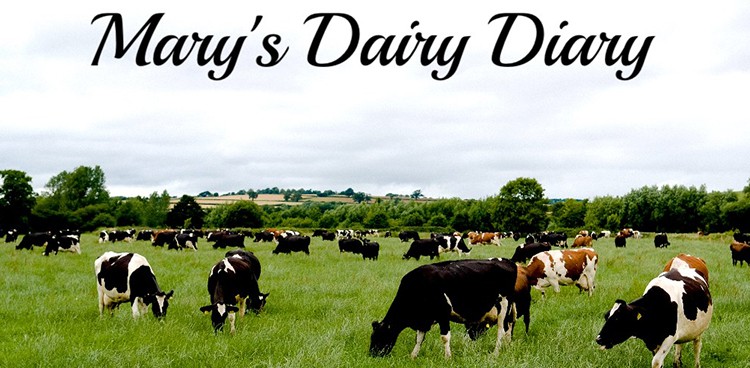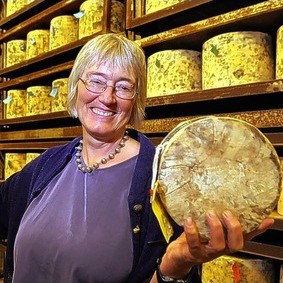
Find out what’s happening this month on Mary Quicke’s farm in Devon, England, where she and the team make the award-winning Quicke’s Traditional Clothbound Cheddar!
We’ve had a mild winter so far, and the weather maps show a different story in the north of the country—wild, wet, and cold. We think we have our local environment under our control, and then Mother Nature gives us a slap. And January is the dark time when the wildest weather hits. The sun barely scrapes the horizon, and I grasp hold of the extra minutes of light every day, trusting the year is turning. I hold onto to each warmer day, knowing the winter has more to deliver. The pastures and hedges take on a bleak greyish hue with low light and the odd frost. The trees sway in the wind with their exquisite tracery of branches, bleak beauty.

I love hearing rain beating down on the roof, and good waterproofs make rain workable. Creatures who live in burrows, holes, setts, earths, and dreys or on branches get sodden, and if it keeps raining, stay sodden. We hope sensitive wildlife will have enough dry weather to keep healthy. And even in the grimmest, darkest weather, you walk through the arable stubbles and charms of finches, hosts of sparrows, and flocks of fieldfares rising up, a resonant sound to hear their wings whoosh all together. I love sharing our beautiful farm with a rich variety of wildlife by providing overwintering fallows, arable stubbles, field margins, and hedges left untrimmed for them.
CROPS – The crops have gone into a sulky dormancy: wet feet, tattered leaves, barely growing. We trust that our work on soils in the autumn will be enough to allow the rain to seep away so the subsoil stays aerated. Soil wet for days on end, where the water cannot drain away, goes methaney and rank.


HEIFERS – Some heifers are out on the grass. It’s always a balance between eating what the animals can safely graze without damage (a surprising amount) and leaving enough leaf to kickstart the growth in the spring. Leaf grows leaf. So we’ll watch the weather, the soil, the grass, and the heifers and make the judgement. Then we’ll bring most out onto kale. We grew that after we harvested wheat early and put into bales. It fermented into whole crop silage, a perfect mix of fibre and starch to balance the proteiny greens. The heifers have a paddock of kale and a bale at a time, and they will slowly move across the field until the spring.
The rest of the heifers are in the barn. I love to see the younger ones dashing around when you put fresh straw in, kicking, leaping it and bunting it with their heads.

COWS – Their pregnant older sisters, due next month, have become more staid, weighed down by their calf and sedated by their own progesterone. They are still curious and enquiring, the friendliest coming up for a scratch behind their ears, the one place they can’t reach, try as they might with their back hooves. You are left with an itchy looking scurf behind your nails, and an appreciative heifer.
The spring cows are out on their winter holidays, recuperating before calving next month. They eat fodder beet, a great column of sweet starch with a green top. It’s hard work for the people tending them, making sure they have enough feed and water and a bit of straw for the all-important fibre. The cows look happy enough, again seeming to go almost dormant. They chew the sweet beet down to the base. At first they pull it out and skae it, wondering what to do, then they realise where the interest lies and get stuck in.
The autumn cows are in the barn, milking. We made silage for them through last year, with feed mixed in when we made it to avoid double handling now: wheat feed (bran and wheat germ) in with the grass silage, and rapeseed meal (left over from crushing seed into vegetable oil). We feed this with apple pomace from our apples sent away to be crushed into juice and cider. The cow’s milk is rich and keeping a good colour, making a good firm cheese.



CHEESE – In the cheese dairy, we have a little lull before the spring cows calve: we have half our normal milk. So we can catch up with cleaning and repairing racks to put cheese on in the spring, and do all those jobs that get left behind in the busy times.
PACKING & STORE – In the packing department, January is normally quiet after Christmas, as people empty their fridges and delay ordering. We are busy this year, sending cheese off to the four corners of the world. It goes by boat, so we send it now for Easter sales in Australia and Valentine’s Day in America.


We send our eager cheeses off on their adventures around the world. It’s lovely to hear how they behave themselves—send us news, tell us what foods and drinks they hang out with!
Mary Quicke
Recipe: Pork Chops

I got this recipe for pork chops from Alaistair David, master butcher at Darts Farm Shop. Make an apple sauce: peel and core some cooking apples. Add sugar—plenty makes it rich. Grate zest of lemon, squeeze the juice in. Simmer until soft. Grill your pork chops and, ten minutes before the end of cooking, put a handful of grated Quickes Traditional Mature Cheddar into the apple sauce, making it unctuous and lush. Coat the chops with apple sauce. Serve with steamed kale or calabrese, and jacket potatoes dripping with Quickes Whey Butter and grated black pepper for a quick winter supper.





